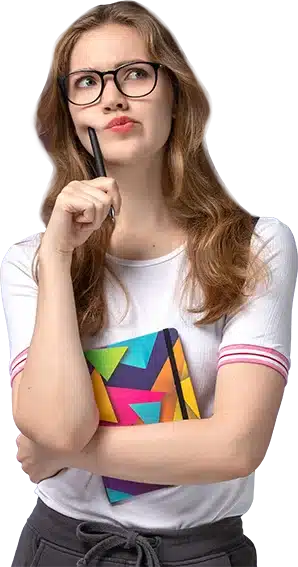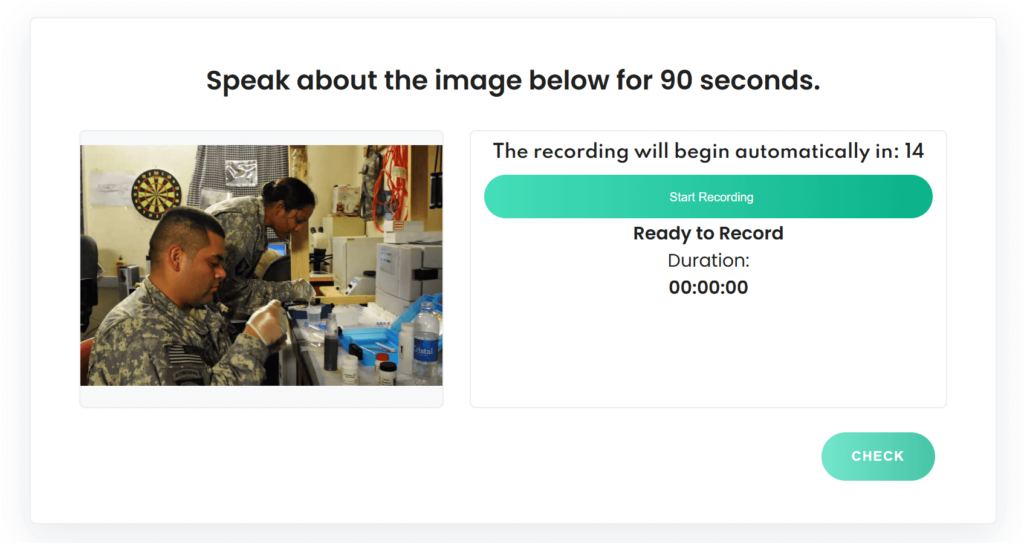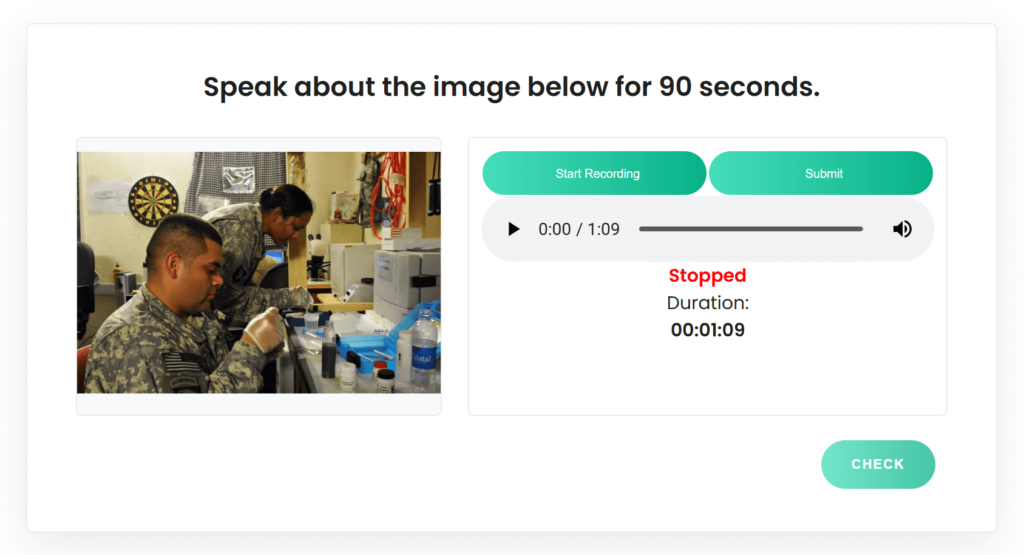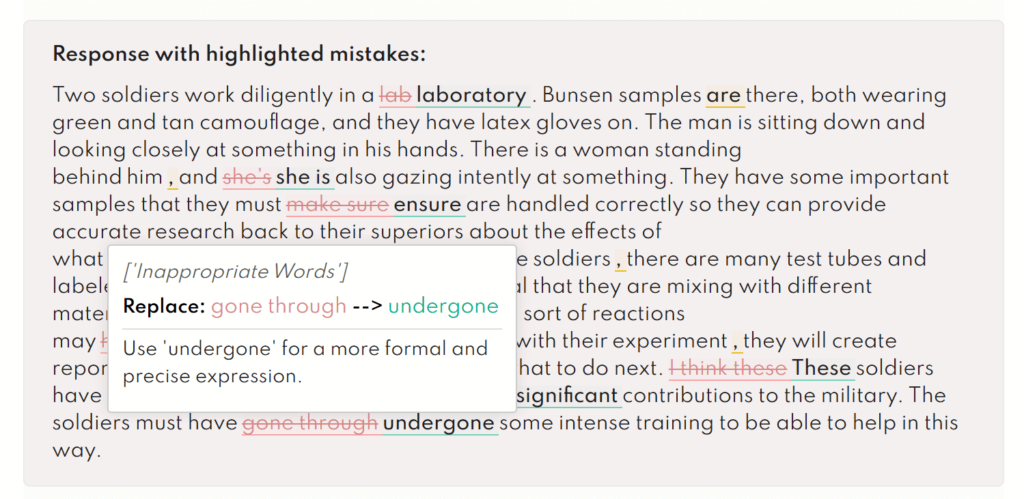Introduction
The Speak About the Photo questions are one of the most challenging question types on the Duolingo English Test.
Why?
Because it looks so simple.
It is just a picture…
…that’s it!
The problem is that speaking for up to 90 seconds about a random image is very difficult.
I bet most native speakers wouldn’t be able to answer this question well without some training.
That is why you must read the tips in this article very, very, carefully. By the end, you will know common mistakes to avoid, exact vocabulary to use, and how to structure your response for a better score on test day.
But before we begin…
If you are ready to try some free practice, check out an example of Speak About the Photo question here.


Over 100 Free DET Practice Questions
Speak About the Photo - Everything You Need to Know
For the Speak About the Photo question type, you will have 20 seconds to prepare once the image appears on the screen and you must speak about it between 30 to 90 seconds. Your answer to this question will contribute to your Conversation and Production scores (Speaking).
Details:
Preparation Time
Use the full 20 second preparation time to mentally prepare your answer.
Question Frequency and Placement
Expect 1 Speak About the Photo question per test, typically placed towards the end.
Speaking Time
You have between 30 to 90 seconds to describe the photo. Aim for at least 45 seconds if you would like a higher score.
Deliver with Confidence
Speak in a clear and confident voice while maintaining a natural rhythm of speech.
No Redos
You can only record your response once, so be sure to stay focused and confident.
Similar to Write About the Photo
This task is basically the same thing as Write About the Photo, but with a longer speaking time requirement.
Speak About the Photo - The Structure
Try to describe this photo.

When considering how to describe this photo, you might be wondering:
- How do I start?
- What exactly in the picture do they want me to describe?
- How can I speak in a way that doesn’t sound like a list?
Here is a basic structure for you to follow:
- Describe the Foreground: Start by describing what people, objects, and actions you notice first. This is usually located in the foreground.
The first thing I notice is a young pharmacist looking down and concentrating on some kind of metal tray. She is wearing a white lab coat and latex gloves, which I assume is to ensure cleanliness.
You can also infer – take a guess – of an action or object you are unsure of, which I did in the underlined part, “I assume is to ensure cleanliness.”
2. Describe the Location: The first thing you notice in the foreground will most likely be followed by the location. Describe what is around what you have already described. Make guesses for anything you are uncertain about.
Next to her is an empty pill bottle and a large white bag labeled cotton balls. In the background, there are hundreds of bottles of pills stacked and organized on different shelves.
3. Make Inferences: Do not hesitate to take a guess about the items in the image and the actions that are being taken. You can even guess what happened before or what is going to happen after this image, which I did in the underlined part of the excerpt below.
This must be a pharmacy and she is one of the pharmacists in charge of filling orders. It looks like she is filling someone’s prescription, preparing the pills and getting ready to move them to the bottle. She must have gone to school for a long time to earn a degree where she could work at a job with so much responsibility.
4. Provide Additional Details: If you still have time, and would like to keep speaking, describe other aspects of the picture that you notice. This will not hurt your score since you are graded most heavily on your vocabulary, grammar, and speech music. Just be sure to sound comfortable and natural.
I can also see a dark red cabinet to the right of the image, which must be where they keep their ingredients.
Speak About the Photo - Key Prepositional Words and Phrases
- Describing the Foreground: in the foreground, up in front, on the bottom left side of the picture, on the bottom right side of the picture
- Describing Background: in the background, towards the back, in the back, on the top left side of the picture, on the top right side of the picture, a little further back
- Describing the Middle: in the middle of the picture, around the center, towards the middle, exactly in the center of the image is
- Prepositions of Place: in, on, under, next to, behind, in front of, above, below, between, opposite, on the left, on the right
- Relation to a Person or Object: next to her, behind her, in front of her, above her, below her, between her and the camera, to the left of her, to the right of her
- To the Left or Right: to the left/right, on the left/right side, on the left/right-hand side, on the top/bottom left/right side of the picture
Speak About the Photo - Verb Tenses and Inferences
- Describing the Foreground: Use the simple present tense to describe people and objects (is, are, has, have).
The first thing I notice is a young pharmacist looking down and concentrating on some kind of metal tray. She is wearing a white lab coat and latex gloves, which I assume is to ensure cleanliness. Next to her is an empty pill bottle and a large white bag labeled cotton balls. In the background, there are hundreds of bottles of pills stacked and organized on different shelves. This must be a pharmacy and she is one of the pharmacists in charge of filling orders. It looks like she is filling someone’s prescription, preparing the pills, and getting ready to move them to the bottle. She must have gone to school for a long time to earn a degree where she could work at a job with so much responsibility. I can also see a dark red cabinet to the right of the image, which must be where they keep their ingredients.
- Describing Actions: Use the present progressive to describe actions taking place in the image (are playing, is working).
The first thing I notice is a young pharmacist looking down and concentrating on some kind of metal tray. She is wearing a white lab coat and latex gloves, which I assume is to ensure cleanliness. Next to her is an empty pill bottle and a large white bag labeled cotton balls. In the background, there are hundreds of bottles of pills stacked and organized on different shelves. This must be a pharmacy and she is one of the pharmacists in charge of filling orders. It looks like she is filling someone’s prescription, preparing the pills, and getting ready to move them to the bottle. She must have gone to school for a long time to earn a degree where she could work at a job with so much responsibility. I can also see a dark red cabinet to the right of the image, which must be where they keep their ingredients.
- Making Inferences: Use phrases like “I think,” “I believe,” “It looks like.”.
The first thing I notice is a young pharmacist looking down and concentrating on some kind of metal tray. She is wearing a white lab coat and latex gloves, which I assume is to ensure cleanliness. Next to her is an empty pill bottle and a large white bag labeled cotton balls. In the background, there are hundreds of bottles of pills stacked and organized on different shelves. This must be a pharmacy and she is one of the pharmacists in charge of filling orders. It looks like she is filling someone’s prescription, preparing the pills, and getting ready to move them to the bottle. She must have gone to school for a long time to earn a degree where she could work at a job with so much responsibility. I can also see a dark red cabinet to the right of the image, which must be where they keep their ingredients.
- Making Inferences: Use modals of possibility (must, could, might, may, can), often followed by “be.”
The first thing I notice is a young pharmacist looking down and concentrating on some kind of metal tray. She is wearing a white lab coat and latex gloves, which I assume is to ensure cleanliness. Next to her is an empty pill bottle and a large white bag labeled cotton balls. In the background, there are hundreds of bottles of pills stacked and organized on different shelves. This must be a pharmacy and she is one of the pharmacists in charge of filling orders. It looks like she is filling someone’s prescription, preparing the pills, and getting ready to move them to the bottle. She must have gone to school for a long time to earn a degree where she could work at a job with so much responsibility. I can also see a dark red cabinet to the right of the image, which must be where they keep their ingredients.
- Past Inferences (optional): Use modals in the past tense (might have, could have, would have, must have) to speculate about past actions.
The first thing I notice is a young pharmacist looking down and concentrating on some kind of metal tray. She is wearing a white lab coat and latex gloves, which I assume is to ensure cleanliness. Next to her is an empty pill bottle and a large white bag labeled cotton balls. In the background, there are hundreds of bottles of pills stacked and organized on different shelves. This must be a pharmacy and she is one of the pharmacists in charge of filling orders. It looks like she is filling someone’s prescription, preparing the pills, and getting ready to move them to the bottle. She must have gone to school for a long time to earn a degree where she could work at a job with so much responsibility. I can also see a dark red cabinet to the right of the image, which must be where they keep their ingredients.
- Future Inferences (optional): Use future tense with “will” to guess what might happen next (e.g., “They will probably go home”).
Speak About the Photo - Avoid These Mistakes
- Repetitive Grammar: Try not to repeat the same grammatical structure, for example, “I see a woman. She is a pharmacist. She works in a pharmacy.” These short, simple, and repetitive sentences will lead to a poor score.
- Short Responses: Try to speak for well over 30 seconds. Aim for at least 45 seconds. However, if you are struggling and have a lot of pauses and silence, just finish up when you are ready anytime after 30 seconds.
- Overly General Language: Avoid words like “nice,” “good,” or “thing,” and be precise in what you are describing. For example, instead of saying “tool” be specific in the tool being used, “hammer.”
- Excessive Pauses and Fillers: Minimize the use of vocal fillers like “uh,” “um,” or “like.”
- Unnatural Pace: Avoid the robot voice and speak the same way you would while having a casual conversation with a friend.
Speak About the Photo - How to Practice
- Practice Without a Timer: Watching a timer count down makes many test-takers nervous. Practice without a timer first. Focus on feeling comfortable since that will help improve your delivery.
- Record and Check: Everyone hates the sound of their voice, but, unfortunately, recording and listening to your response is one of the best ways to improve. Do it.
- Seek Feedback: Asking a teacher to assess your speaking is one of the most valuable investments you can make. Experienced teachers can tell you exactly what you need to do to improve.
- Practice with a Variety of Prompts: Use the free Speak About the Photo questions on the Duolingo website and also on TST Prep to gain exposure to a variety of topics.
- Youglish: Type in any word or phrase and you can find dozens of examples of native speakers pronouncing them.
- Free4Talk: You can practice speaking English with other like-minded language learners for free.
Speak About the Photo - Free Practice with TST Prep

On the TST Prep platform, the Read and Complete question is designed to evaluate your reading and vocabulary skills. You will see a passage with missing letters, and your task is to type the correct letters to complete the text. Pay close attention to the context and grammar of the sentence to find the right words. This question helps assess your ability to understand and predict language patterns accurately.

On the TST Prep platform, the Read and Complete question is designed to evaluate your reading and vocabulary skills. You will see a passage with missing letters, and your task is to type the correct letters to complete the text. Pay close attention to the context and grammar of the sentence to find the right words. This question helps assess your ability to understand and predict language patterns accurately.

On the TST Prep platform, the Read and Complete question is designed to evaluate your reading and vocabulary skills. You will see a passage with missing letters, and your task is to type the correct letters to complete the text. Pay close attention to the context and grammar of the sentence to find the right words. This question helps assess your ability to understand and predict language patterns accurately.

On the TST Prep platform, the Read and Complete question is designed to evaluate your reading and vocabulary skills. You will see a passage with missing letters, and your task is to type the correct letters to complete the text. Pay close attention to the context and grammar of the sentence to find the right words. This question helps assess your ability to understand and predict language patterns accurately.


Over 100 Free DET Practice Questions
Conclusion
The Speak About the Photo question type is tough.
It requires you to provide detailed descriptions while employing a variety of vocabulary and avoiding repetitive grammatical structures.
Be sure to record your voice, speak for at least 45 seconds, and make sure you sound clear, comfortable, and confident. Review these tips carefully and you will score high on test day.
Keep these tips and ideas in mind when you practice and when you take the exam and you will do great!
Did that help?
Do you have any more tips for this question type?
Share in the comments below and help us all improve.









